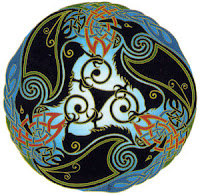 From the Emerald Isle comes a
Goddess whose very existence has confused scholars as to whether she is actually a Deity, or merely a noun describing a number of similar
Goddesses. Then again, maybe She is
both. This shapeshifter is the Irish
battle Goddess, the Morrighan.
From the Emerald Isle comes a
Goddess whose very existence has confused scholars as to whether she is actually a Deity, or merely a noun describing a number of similar
Goddesses. Then again, maybe She is
both. This shapeshifter is the Irish
battle Goddess, the Morrighan.From the earliest of Irish myths that recounted how the mythical faery race, the Tuatha de Dannan, battled not only the prehistoric Fomorians but also the Fir Bolgs, there has been some connection with the Morrighan. This is because it was She who chose to take the side of the de Dannan peoples to whom She lent Her magical skills and powers, enabling them to win Ireland for themselves.
 Meaning “Great" or "phantom" Queen, the Morrighan was
often depicted as a mysterious woman, a shapeshifter, prophetess, and lover of
the “Good God’, the Dagda. She appeared
within the myths concerning the Ulster hero Cuchulainn, and when he ignored Her sexual advances, the Goddess sought revenge upon the young (yet rather ignorant)
hero that included appearing as the elderly “Washer
of the Ford”. Such an image would put the fear into even the
bravest of warrior when he came across Her as it was believed that the
clothing She was washing belonged to those who were about to die in battle.
Meaning “Great" or "phantom" Queen, the Morrighan was
often depicted as a mysterious woman, a shapeshifter, prophetess, and lover of
the “Good God’, the Dagda. She appeared
within the myths concerning the Ulster hero Cuchulainn, and when he ignored Her sexual advances, the Goddess sought revenge upon the young (yet rather ignorant)
hero that included appearing as the elderly “Washer
of the Ford”. Such an image would put the fear into even the
bravest of warrior when he came across Her as it was believed that the
clothing She was washing belonged to those who were about to die in battle.Scholar, Miranda Green, states that the Morrighan is part of a triad, consisting of the Morrighan Herself (the sovereign-ruler), Badbh (a War Goddess) and Macha (promoter of fertility). Another common belief is that there were three Goddesses who ruled the battle fields (similar to the Norse Valkyries) who were known collectively as the Morrighan.
 The first of these Goddesses was
Badbh (as mentioned above), whose name also appeared to refer to a group of
Goddesses as opposed to just one. The
most common name was that of Badbh Catha, meaning “the battle crow”, which described
the crows feasting on the flesh of the fallen on the battlefield, and She gloated
over the blood shed.
The first of these Goddesses was
Badbh (as mentioned above), whose name also appeared to refer to a group of
Goddesses as opposed to just one. The
most common name was that of Badbh Catha, meaning “the battle crow”, which described
the crows feasting on the flesh of the fallen on the battlefield, and She gloated
over the blood shed.Macha (meaning “field” or “pasture” which relates to Her connection with fertility) appeared as the aspect that instigated the battles. Like Her Norse counterpart, the Valkyries, Macha also claimed the souls (to the Celts this was located in the head) of the best of the fallen warriors.
The third aspect of the triple battle Goddess was the lesser known Neman. With her name meaning “frenzy” or “panic”, or even “venomous”, this seemed to indicate how She intimidated the losing side of the battle with Her shrieks.
 Today the Morrighan is commonly
depicted as an elderly Crone or Hag Goddess.
However, this is not necessary accurately as She shapeshifts through all
three of the standardised “triple” Goddess aspects (the Maiden, Mother and
Crone). To those who work with Her
intimately, She appears ageless and in a form that is required for the task at
hand.
Today the Morrighan is commonly
depicted as an elderly Crone or Hag Goddess.
However, this is not necessary accurately as She shapeshifts through all
three of the standardised “triple” Goddess aspects (the Maiden, Mother and
Crone). To those who work with Her
intimately, She appears ageless and in a form that is required for the task at
hand.
A special anthology dedicated to the Morrighan entitled By Blood, Bone and Blade is currently calling for submissions, in particular artwork. For more information, please visit the Neos Alexandria web site.


No comments:
Post a Comment